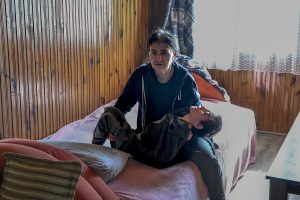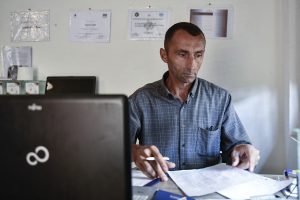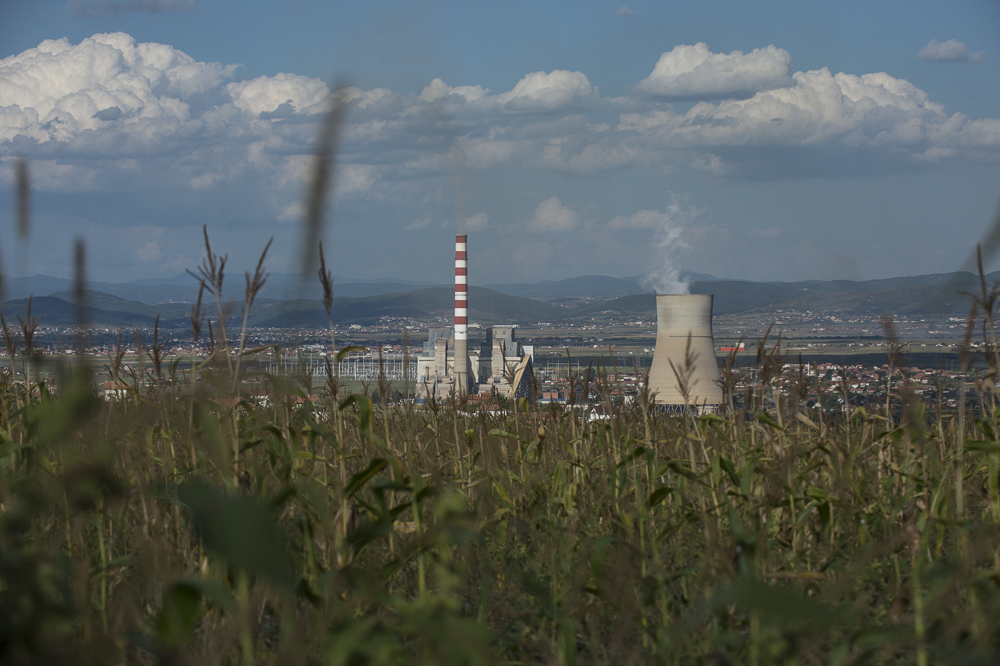Sitting at the foothills of the beautiful Accursed Mountain range, Peja is one of the coldest cities in Kosovo. Even on the morning of September 23, the cold could be felt. When it already feels cold in September you can’t help but think of the coming winter.
In the neighborhood Lagjen e Gjimnazit, near the Austro-Hungarian cemetery and near where the characteristic one-story houses of Peja’s old neighborhoods clash with the new buildings, a struggle for survival is taking place behind the old wooden door of a small house. From the courtyard, it is obvious that the economic situation of the house’s inhabitants differs from the neighbors. There is no air conditioning unit attached to the house and no carefully arranged wood stack, as the other houses have. A cat was wandering around as Kujtim Halili, in his 40s, led towards the door.
He cracked open the door — as if hesitant to show what was inside — and entered into a cold, dark, wood paneled room. A white wood-burning stove with some food on it sat in the corner surrounded by old stockpots.
Elfije Murataj was inside. Though she suffers from Parkinson’s disease, which makes it difficult for her to move, she looks after her grandson, Albatrit, eight years old, who since birth has been unable to see or move.
“Since he was born, I have always stayed close to him. I’ve had Parkinson’s for two years now, and often I’m falling down too,” Murataj said. Her daughter, Albatrit’s mother, had gone out looking for a job or to find some help, because winter is approaching.
“In the last two days a small heater that we had broke down. This morning, it felt as cold as a refrigerator in here. For the winter, I don’t know how we will manage,” Murataj said, her words breaking as she started to cry. With little money to buy wood or pay the electricity bill, the winter for Murataj, Albatrit and their whole family will be difficult.
They had been kicked out from their previous rented house due to an unpaid bill.
“Here, as well, we have a debt of 300 euros, but sometimes we reduce the debt by giving 30 or 40 euros,” Murataj said, holding her grandson close. With the social assistance they receive for Albatrit, about 300 euros per month, they manage to live.
“If it wasn’t for Kujta I don’t know how we would have managed with the rent,” she said, nodding towards Halili. “He helps us as much as he can.”
He moved his head and folded his arms, and said quietly, “As much as we can, we will do.” The old door closes as Kujta, as everyone calls him, leads the way again.

Elfije Murataj and her family live on only 300 euros per month, which they receive as social assistance for Albatrit. Photo: Atdhe Mulla / K2.0.
Inflation and a difficult winter
Kujtim Halili lives in the Xhemajl Kada neighborhood, as Pejons call it, in a small alley little wider than a car. In 2007, he started helping the needy by accident and since then has never stopped. Donations from family members and the diaspora eventually piled up and pushed him to channel them through the Gjurmë e Pejës association, which distributes the donations. Even though he helps 800 households every year, his name and photos rarely appear in the media.
Halili used to work at the main family medicine center in Peja as a laboratory technician, but he terminated his contract in anticipation of going abroad for work. That, though, fell through and he is now seeking other employment.
In his backyard he has converted a room into an office and aid depot. “Some people bring me aid because they know that I help, and others, like big companies, I contact and they bring aid to me. I am gathering as much as I can, but the need is great,” said Halili, while looking at the list of 800 needy families in Peja and the surrounding villages. The number of needy families on his list has increased in the past few years.
“There are cases when someone comes to the door late and says that some children don’t have anything to eat tonight,” he said, and so he keeps around 4 or 5 bags of flour in the warehouse.
Now, Halili is getting ready for winter, which, amid warnings of energy cuts and the high price of wood, looks set to be difficult.
“In Peja, a cubic meter of wood ranges from between 50 to 70 euros,” he said, pausing for a moment to think. “For example, if I had 200 cubic meters of wood at the moment, and distributed two cubic meters of wood to 100 families, it would be good, even though to get through winter you need at least 4 or 5 cubic meters,” he said.

Kujtim Halili helps 800 needy families in Peja with the donations he collects. Photo: Atdhe Mulla / K2.0.
Halili’s concerns are well founded. The price of wood and pellets, which are widely used for domestic heating, have doubled. A ton of coal is now sold for 75 euros, even though it has not been allowed to be burnt in bulk since 2019. The price of a cubic meter of wood has reached 100 euros, which marks an increase of 100% from last year. Pellets now cost between 540 and 700 euros per ton, an increase of 125 to 190%.
Even electricity, which is often used for domestic heating, has become more expensive. Last winter, reductions left Kosovo without power every four hours for several weeks. This was resolved temporarily by a price increase for electricity and an additional surcharge on consumers who used large amounts of electricity.
The block tariff introduced in February 2022
Those who spend up to 800 kWh in a month will not see a price increase. Daytime tariffs for them are set at 6.75 cents per kWh and 3.89 cents per kWh at night. Those who exceed the 800 kWh per month threshold will pay subsequent energy usage at a rate of 12.52 cents per daytime kWh and 5.9 cents per nighttime kWh.
For this winter, the government has warned that there will be energy blackouts when demand increases, as Kosovo will not have enough energy for everyone.
Most of the energy in Kosovo comes from domestic production. Since the war in Kosovo, when the Kosovo Energy Corporation (KEC) plants were damaged, problems with electricity have been ever present. Aging infrastructure — the 1960s Kosova A Thermal Power Plant and the 1980s Kosova B plant — are the main source of power.
The plants are serviced every year and do not produce electricity during repairs. This was the reason for the energy blackouts in August this year. However, even if there was no need for repairs, these two power plants, together with alternative energy sources, would still not cover electricity consumption when temperatures drop. Therefore, electricity must be imported. But energy prices on the international exchange are very high.
In the past, during peak winter consumption, one megawatt per hour could be bought for between 80 and 100 euros on the Hungarian exchange, Hupex. Today, before winter begins in earnest, the price can reach as high as 800 euros in off peak moments and is expected to reach 1,000 euros. The price increase is a result of supply and demand issues, as well as the global consequences of the war in Ukraine, which has disrupted Russian gas supplies to a large part of Europe.
Unable to cover the increased costs, the Electricity Distribution Company in Kosovo (KEDS) has chosen energy blackouts.
Kosovars have few alternatives to energy blackouts and pleas to save electricity, but one alternative for many individuals is relying on wood, pellets and coal for heating. Prishtina and Gjakova are the only cities with central heating systems, which can help residents save on expenses.
Most residents of Kosovo do not have access to central heating
Out of 200,000 consumers in Prishtina, only 16,000 receive central heating from October 15 to April 15. Public institutions in Prishtina are generally connected to central heating as well. In Gjakova, the Gjakova Heating Center heats roughly 110,000 square meters of indoor space, which includes the city's public institutions. A central heating system similar to the one in Gjakova is dysfunctional in Mitrovica.
Viktor Buzhala from KEDS also said that the winter will not be easy. The increase in consumption has already started, marking an increase of 5% compared to last year, even though it is not the peak of the season.
According to him, expenditure is currently low, since we are at a time when citizens do not use electricity either for cooling through air conditioners or for heating, and consumption peaks at over 700 megawatts per hour. During the winter, the consumption peak goes up to 1,300 megawatts per hour.
“We know that a difficult winter awaits us in terms of electricity,” said Buzhala. According to him, the impact will depend on three factors: local production, the consumption level and prices in international markets.
Delayed preparation
Uncertainty about electricity supply affects manufacturing and service businesses; this is clear from the large number of private generators outside businesses. Lendrit Palushi from the company Frutex, which produces and exports drinks, said that under normal conditions the company operates five production lines, which put 500,000 units of beverages on the market per day. But when the energy cuts out, the situation changes.
“While using the generator, we are forced to reduce production from five to two production lines, as the generator costs are too high,” said Palushi. “The losses are great because both the production capacity decreases and oil costs increase.”

The Kosova A and Kosova B thermal power plants continue to be the main source of electricity for the country. Photo: Atdhe Mulla / K2.0.
Arian Vranica from the Gastronomes Association of Kosovo also echoes this sentiment. He said that if there are frequent winter energy blackouts, the prices of products will increase, there will be a loss of workers and a decrease in consumption, forcing businesses to close.
For those in the bar and restaurant industry, Vranica said that almost all are prepared with UPS devices, which can temporarily replace the electricity when it cuts out and protect equipment from power surges when the transition from the power grid to the generator takes place.
“And generators as well, it’s an investment that again can vary according to the size of the generators, but we have cases where a lot of medium sized businesses are being forced to get either bigger generators, or combine a part with inventory in order to at least to distribute fiscal coupons at the time of service,” said Vranica.
In order to mitigate the lack of domestic production with imported electricity, the government in February of this year pledged 90 million euros to subsidize the energy that KEDS imports, of which around 60 million euros have been allocated so far.
“We try as much as possible to be prepared for winter with our generating facilities,” said Artane Rizvanolli, Minister of the Economy. The government’s main approach to electricity insecurity continues to be calling for saving energy. Some support measures have been launched to encourage this.

Minister of Economy Artane Rizvanolli calls for saving electricity. Photo: Ministry of Economy.
At the beginning of September, energy was included as part of the package dealing with inflation, with a subsidy introduced for those who saved compared to last year. If a household spent 1,000 kWh in September of last year, while in September of this year it spent 900 kWh, it will be subsidized for 20% of the value saved, which in this case would be 100 kWh. According to the announcement, there will be no need for applications as data will be obtained from the Energy Regulatory Office and the subsidy will be seen on the consumer’s bill.
Another subsidy support measure has been launched recently — the government allocated 6 million euros for investment in energy efficiency measures, which according to Minister Rizvanolli, are designed to reduce the need to import electricity.
Those who own houses and are not connected to central heating will have the right to apply for subsidies. The government will subsidize between 10% and 90% for the purchase of heat pumps, boilers, stoves and efficient air conditioners that use less energy. Those who use electricity for heating can benefit from this subsidy and those that in one of the three months, December 2021, January or February 2022, used more than 800 kWh.
Buying a wood burning stove or boiler is not necessarily the only problem facing poor families or even those with a middle income, as they are also faced with the high price of wood and other fuels.
According to Minister Rizvanolli, the 6 million euros invested in energy efficiency are expected to save 19 million euros worth of electricity, which will then be used for importing energy.
Subsidizing equipment through efficiency measures
Boilers that use wood, pellets or biomass briquettes will be subsidized up to 70% of the investment value or up to 1,200 euros.
Heat pumps that reduce electricity consumption by up to 70% will be subsidized up to 30% or up to 2,500 euros.
Efficient air conditioners that reduce electricity costs by up to 70% will be subsidized up to 40% of the value or up to 400 euros.
Individual wood burning stoves with efficient biomass wood value for families that are part of assistance schemes will be subsidized 90% or up to 560 euros, while for families that are not beneficiaries of social schemes these stoves will be subsidized up to 70% or up to 435 euros.
Burim Ejupi, the executive director of the Institute for Development Policy (INDEP) believes the 6 million euro investment in energy efficiency has come very late.
“Are we late? We have been late since the day electricity became more expensive, on February 8, 2022, the government knew that winter would come again,” said Ejupi. “From then until today, eight months have passed and no measures have been implemented.”
According to him, the government has delayed the distribution of the import subsidy to KEDS and although it has declared that it will set a price ceiling for pellets, it has not done so. He also said that the government could expand the scope of the Efficiency Fund, since according to the law, it currently only deals with public buildings. This fund invests in the efficiency of old buildings that do not have energy efficient facades and windows.
“I have never received a more expensive bill for September. It was colder than before, so look at the bill,” said Ejupi.
Looking towards renewable resources
Since the end of the war, there have been plans to add another power plant to Kosova A and Kosova B, originally named Kosova C and now known as Kosova e Re. In the end, the project failed. For some governments it was only a plan, others did not deal with it, others signed agreements and chose investors who then withdrew. The project, with a production capacity of 500 MgW/h, failed. In the end the World Bank chose not to finance coal fired power plants because of global policies against the use of fossil fuels.
Global policies to slow the emission of greenhouse gasses — which are released from burning of fossil fuels, the cause of the climate crisis — support the generation of electricity in renewable forms such as from solar panels, wind power or hydropower. However, Kosovo generates only about 250 GWh from these sources out of over 6,000 GMWh of total energy production, or roughly 4%.
The INDEP institute has continuously issued reports and recommendations supporting green energy, but little has been done to start increasing solar power production in Kosovo.
“We have proposed in our campaign that the government subsidize solar panels for businesses that have reduced their consumption significantly. Since 2019, we have proposed to remove the VAT for households by 18% [for the purchase of solar panels] and so each citizen who has a roof and could have been able to invest in solar panels, which saves the electricity that it produces from the sun and does not use any from the power grid,” said Ejupi.

Burim Ejupi, director of the Institute for Development Policy (INDEP), criticizes the government for its delayed response to the energy crisis. Photo: Atdhe Mulla / K2.0.
Ejupi has also called for the government to expand the scope of the Efficiency Fund, since according to the law, it currently only pertains to public buildings.
Ejupi also criticizes the government’s decision in April, to distribute over 100 million euros in the form of 100 euro payouts to individual students and workers. According to Ejupi, this was one of the government’s biggest mistakes because with that money, a lot could have been done for the energy sector. According to him, this money could have been allocated for solar panels or housing insolation. Overall, he is surprised that local institutions are not organizing a larger campaign to save energy.
“The government has no vision, there is no policy,” he said.
The government is working on the draft of the new Energy Strategy. According to Minister Rizvanolli, this draft foresees the improvement and updating of production capacities in the Kosova A and Kosova B power plants. However, the goal of Kosovo, according to the minister, is to generate 35% of energy production from renewable sources.
According to her, the strategy foresees at least 1,400 new MWh of wind and solar capacity by 2030 and an increase greeny energy production capacity from 5% of the total production to 35%. Rizvanolli also said that the government plans to open the Auction for Renewable Energy Sources where those who wish to build generating facilities with renewable energy enter the auction, and the winner is determined based on the lowest price among qualified bidders. Even though the solar energy auction was expected to open at the end of the year, Rizvanolli said it is a possibility that it could be delayed until early 2023.
Renewable energy sources are increasingly seen as a solution by businesses as well. Frutex’s Palushi said that seeing the current crisis with electricity all over the world and the situation in Kosovo, they are moving towards generating their own solar energy.
While some businesses have opportunities to create their own solutions, most families in Kosovo will depend on KEC, wood, pellets and coal. These fuels are at odds with the goals of clean renewable energy.
But support measures will not be enough to ensure smoke is coming out of the chimneys of poor families this winter. Kujtim Halili’s long list shows that hundreds of families are looking for aid.
In the end, Halili didn’t lead us to his house. He went instead down the Korza of Peja to meet some businesses that have called him to ask for aid, because “the winter will be difficult.”
Feature Image: Atdhe Mulla / K2.0.
The content of this article is the sole responsibility of K2.0.
Curious about how our journalism is funded? Learn more here.






